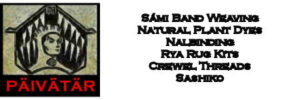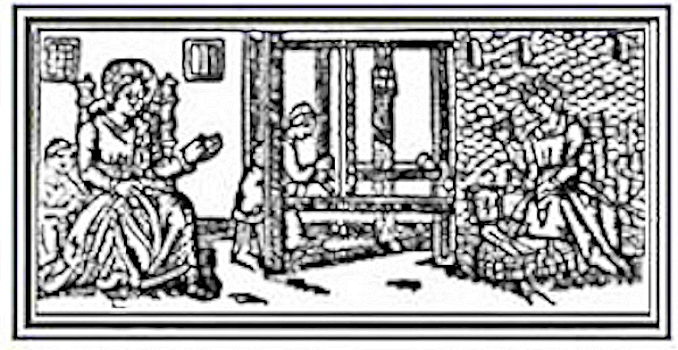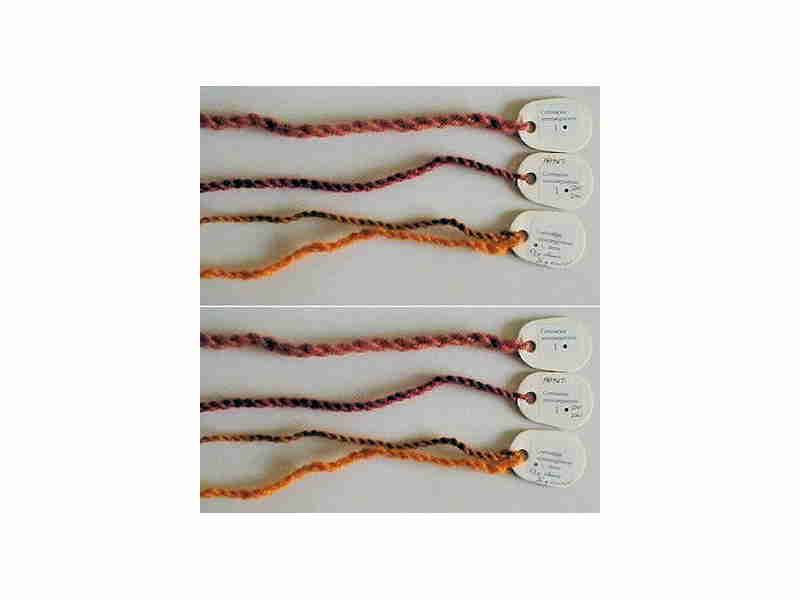Cortinarius semisanguineus – Yellow, Orange dye from stems
Reds, pinks from caps
FI: Verihelttaseitikki
Alum Mordant
3 litres water
25 grams alum
10 grams cream of Tartar
Bring to boil and then let cool
100 gram wool yarn tied in skeins
Rinse the clean washed yarn in cool water
Add the yarn into the cool mordant bath and bring it to 80-90 C degrees
Simmer for 1 hour
Remove and let cool
Mushroom Fungi Dye Bath
Separate the mushroom caps from the stems and use them as separate dye baths. The caps will give a red dye colour and the stems a yellow/orange dye.
If using dried mushrooms soak them in water for a few hours until soft.
100 grams dried mushrooms
5 litres water
Bring to boil and simmer for 2-3 hours
Let dyebath cool
Strain the liquid and store the cooked mushrooms. They can be used again in an afterbath
Add mordanted yarn to strained dyebath liquid
Return to heat and simmer for 1 hour at 80-90 degrees Celsius or longer for stronger colour.
Remove from heat source and let cool
Rinse in water that is of similar temperature as dyebath to avoid shocking the yarn and causing felting to occur.
More about Fungi Dyes
Tom Volk’s Fungus of the Month – Sept 99
Cortinarius semisanguineus – Eleanor Yarrow Slide Collection
Mushroom Tours in Mexico
Fungi in Finland and Sweden
Fungal Records Database of Britain and Ireland
Mordants
How to Make an Alum Mordant
How to Scour and Mordant Cotton and Linen
More About Fungi Dyes
Fungi Dye: Pisolithus arhizus
Fungi Dye: Boletopsis Grisea
Fungi Dye: Hapolopilus Rutilans
Fungi Dyes Cortinarius Semisanguineus
Fungi Dye: Phaeolus schweinitzii
Natural Dye Books
Wild Color, Revised and Updated Edition: The Complete Guide to Making and Using Natural Dyes
Botanical Colour at your Fingertips
The Modern Natural Dyer: A Comprehensive Guide to Dyeing Silk, Wool, Linen and Cotton at Home
A Weaver’s Garden: Growing Plants for Natural Dyes and Fibers
The Rainbow Beneath My Feet: A Mushroom Dyer’s Field Guide
 LONGTHREAD MEDIA VIDEO
LONGTHREAD MEDIA VIDEO
 LONGTHREAD MEDIA SUBSCRIPTIONS
HANDWOVEN MAGAZINE
PIECEWORK MAGAZINE
SPINOFF MAGAZINE
LEARN LONGTHREAD MEDIA
PAIVATAR HANDMADE
LONGTHREAD MEDIA SUBSCRIPTIONS
HANDWOVEN MAGAZINE
PIECEWORK MAGAZINE
SPINOFF MAGAZINE
LEARN LONGTHREAD MEDIA
PAIVATAR HANDMADE
 Paivatar on YouTube
Visit my YouTube channel for how-to craft videos.
Paivatar on YouTube
Visit my YouTube channel for how-to craft videos.
Or Please visit my Channel on Rumble for more how-to videos.
https://rumble.com/Paivatar
LIVE STREAMS - Paivatar Studio
KICK
TWITCH MAKERS&CRAFTING
YOUTUBE
Categories: Fungi Dyes





